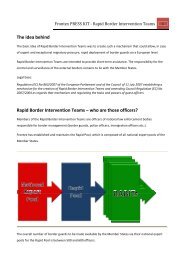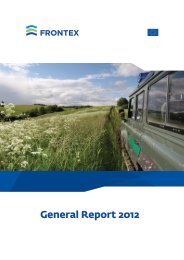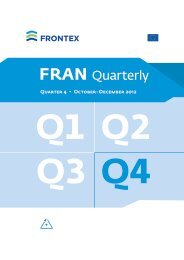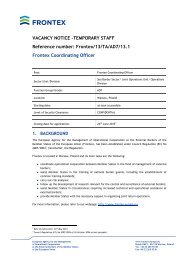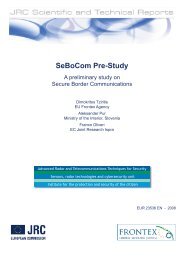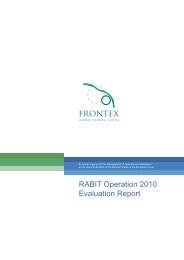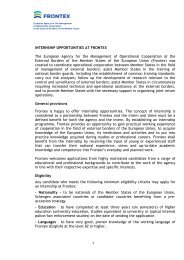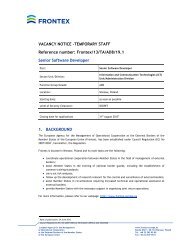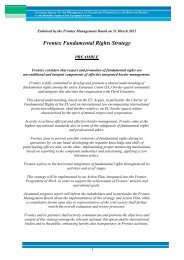Download PDF - Frontex
Download PDF - Frontex
Download PDF - Frontex
Create successful ePaper yourself
Turn your PDF publications into a flip-book with our unique Google optimized e-Paper software.
Mediterranean route or the Western African route. Larger flows are more likely to develop on<br />
the Central Mediterranean route than on the other two routes, mostly because of its<br />
proximity to Tunisia, Libya and Egypt, where political instability and high unemployment<br />
rates among young people is pushing citizens away from their countries and where there is<br />
evidence of well-organised facilitation networks.<br />
On the Western Mediterranean route, the situation remains of concern because of the<br />
increasing trend of illegal border-crossings reported throughout 2011. According to reported<br />
detections, the situation on the Western African route has been mostly under control since<br />
2008 but remains critically dependant of the implementation of effective return agreements<br />
between Spain and western African countries. Should these agreements be jeopardised,<br />
irregular migration, pushed by high unemployment and poverty, is likely to resume quickly<br />
despite increased surveillance.<br />
The composition of the immigration flow is dependent on the route and the countries of<br />
departure, but includes a large majority of western and North Africans. Mostly economically<br />
driven, irregular migration on these routes is also increasingly a result of the humanitarian<br />
crisis in western and northern African countries. Facilitators are increasingly recruiting their<br />
candidates for illegal border-crossings from the group that is most vulnerable to THB, i.e.<br />
women and children, causing increasing challenges for border control authorities.<br />
1.7.4. Risk of border-control authorities faced with large numbers of people in<br />
search of international protection<br />
Given the currently volatile and unstable security situation in the vicinity of the EU, there is<br />
an increasing risk of political and humanitarian crises in third countries resulting in large<br />
numbers of people in search of international protection being displaced to the land and sea<br />
borders of the EU. The most likely pressures are linked to the situations in North Africa and<br />
the Middle East.<br />
In addition, the situation in western African countries like Nigeria may also trigger flows of<br />
people in search of international protection to the external borders. In addition, facilitators<br />
of illegal border-crossing often recommend that migrants apply for international protection if<br />
detected at the external borders, only to abscond from asylum centres only a few days later.<br />
This threat is predominantly linked to irregular transit migration through the Western Balkan<br />
route and possibly, more sporadically, along the eastern land border. Facilitators are<br />
exploiting the period, often several months, required for assessing asylum applications, and<br />
the lack of a common policy on international protection at the EU level, as part of the modus<br />
operandi proposed in their packages to the migrants. Their illegal activities are also thriving<br />
because of the still insufficient coordination between border-control and other lawenforcement<br />
authorities with asylum authorities.<br />
When applications for international protection are made in large numbers as part of a modus<br />
operandi to illegally enter the EU, it overloads border-control authorities, thus diluting<br />
Page 19 of 142



